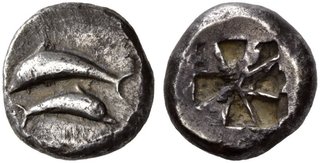This record is provided by CoinArchives, a database of numismatic auction catalogs.
Important copyright information:
The data below is presented by permission of the copyright holder(s). Reproduction is allowed only by authorization from Numismatica Ars Classica.
Important copyright information:
The data below is presented by permission of the copyright holder(s). Reproduction is allowed only by authorization from Numismatica Ars Classica.
| Numismatica Ars Classica > Auction 78 | Auction date: 26 May 2014 |
| Lot number: 274 | |
| Lot description: Greek Coins Thera Stater circa 525/520-500, AR 12.28 g. Two dolphins swimming in opposite directions. Rev. Incuse square divided into eight triangles, some of which are filled. Traité pl. LXII, 17 (these dies). Rosen 243. Sheedy 16i (this coin). SNG Delepierre 2459. Very rare and in exceptional condition for this difficult issue. Struck on unusually good metal and with a pleasant old cabinet tone, extremely fine Ex NFA-Leu 16-18 October 1984, Garrett part II, 232. Privately purchased from J. Schulman in 1930. Greek economic prosperity in the late archaic age spread well beyond mainland Greece and the western shores of Asia Minor. Indeed, the wealth generated from vigorous trade in the Aegean found its way to many islands, including Thera (modern Santorini), the southernmost of the Cyclades. Evidence of economic success on Thera in the archaic and classical periods can be seen not only in the archaeological record, but also in a brief but substantial coinage that is thought to have been produced for the island in the last two decades of the 6th Century B.C. This distinctive coinage, showing two dolphins swimming in opposite directions, is attributed to Thera based on slight but reasonably convincing hoard evidence. Clearly, this coinage was a limited experiment, for it was never repeated. In all likelihood the islanders found it convenient enough to rely on foreign issues – principally staters of Aegina – to support whatever needs could not be satisfied through bartering. The silver coins attributed to Thera were produced in such quantities that among Cycladic mints in the archaic period they rank second only to those of Naxos. The great majority of these were Aeginetic-weight staters, which were supplemented with much smaller emissions of drachms, obols and hemiobols. Though the fractions would have been retained for local use, the staters of Thera occur in hoards found in Asia Minor, the Levant and Egypt, indicating they often were exported in trade. Estimate: 8000 CHF |  |


